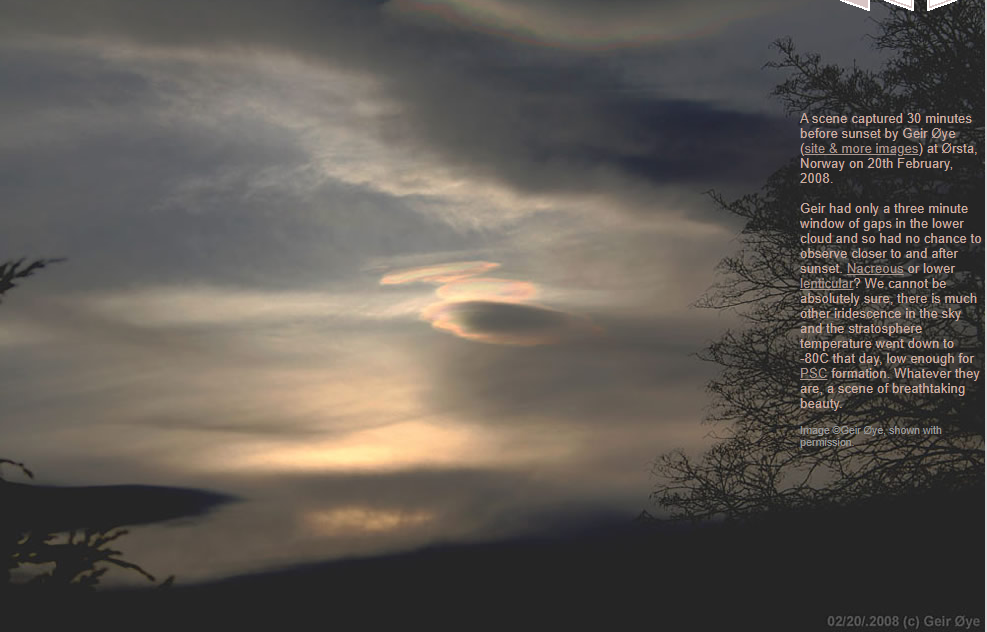Nacreous Clouds, Orsta Norway
Nacreous Clouds: A Spectacular Display in Ørsta, Norway
On the 20th of February, 2008, a breathtaking scene unfolded in Ørsta, Norway. Geir Øye, an avid photographer, captured a mesmerizing image of the sky just 30 minutes before sunset. This remarkable photograph showcases a unique atmospheric phenomenon known as nacreous clouds or polar stratospheric clouds (PSCs). The image reveals an array of vibrant colors and intricate patterns, leaving viewers in awe of nature's beauty.
Nacreous clouds are often mistaken for lower lenticular clouds due to their ethereal appearance. However, distinguishing between the two can be challenging, especially when there is an abundance of iridescence in the sky. In the case of Geir Øye's photograph, the presence of other iridescent elements adds to the mystery and wonder surrounding these captivating formations. It is important to note that on this particular day, the temperature in the stratosphere dropped to a staggering -80°C, creating the ideal conditions for PSC formation.
These extraordinary clouds are a rare sight to behold. They occur in the winter months at high latitudes, typically between 65° and 75° latitude. Ørsta, Norway, located at approximately 62° latitude, falls within this range, making it a prime location for witnessing this atmospheric spectacle. Nacreous clouds are most commonly observed during sunrise or sunset when the sun is low on the horizon, casting a warm glow on the delicate ice crystals that compose these clouds.
The formation of nacreous clouds is intricately linked to the extreme cold temperatures found in the stratosphere. At such low temperatures, water vapor freezes into ice crystals, forming thin clouds in the polar stratospheric region. These ice crystals are unique in their composition, consisting primarily of nitric acid and water. The interaction between sunlight and these tiny ice particles results in the stunning display of colors seen in nacreous clouds.
The colors exhibited by nacreous clouds are a result of diffraction and scattering of sunlight. As sunlight passes through the ice crystals, it undergoes a process similar to what occurs in a prism. This phenomenon causes the light to bend and separate into its component colors, resulting in vibrant hues such as pinks, purples, blues, and greens. The intricate patterns observed in nacreous clouds are a result of the complex interplay between the orientation of the ice crystals and the angle of sunlight.
Nacreous clouds not only captivate the eyes but also serve as indicators of environmental conditions. These clouds form at altitudes of approximately 15 to 25 kilometers, where the presence of certain chemicals can have a significant impact on the Earth's ozone layer. The occurrence of PSCs provides scientists with valuable information about the state of the ozone layer and helps monitor any potential ozone depletion.
In conclusion, Geir Øye's photograph of nacreous clouds in Ørsta, Norway, offers a glimpse into the captivating world of atmospheric optics. These rare and mesmerizing formations, often mistaken for lower lenticular clouds, create a breathtaking display of vibrant colors and intricate patterns. The extreme cold temperatures in the stratosphere, coupled with specific chemical compositions, give rise to these unique cloud formations. Witnessing nacreous clouds is a truly remarkable experience that not only astounds viewers but also provides valuable insights into our planet's atmospheric conditions.

A scene captured 30 minutes before sunset by Geir Øye (site & more images) at Ørsta, Norway on 20th February, 2008.
Geir had only a three minute window of gaps in the lower cloud and so had no chance to observe closer to and after sunset. Nacreous or lower lenticular? We cannot be absolutely sure, there is much other iridescence in the sky and the stratosphere temperature went down to -80C that day, low enough for PSC formation. Whatever they are, a scene of breathtaking beauty.
Image ©Geir Øye, shown with permission.
Note: this article has been automatically converted from the old site and may not appear as intended. You can find the original article here.
Reference Atmospheric Optics
If you use any of the definitions, information, or data presented on Atmospheric Optics, please copy the link or reference below to properly credit us as the reference source. Thank you!
-
<a href="https://atoptics.co.uk/blog/nacreous-clouds-orsta-norway/">Nacreous Clouds, Orsta Norway</a>
-
"Nacreous Clouds, Orsta Norway". Atmospheric Optics. Accessed on December 23, 2024. https://atoptics.co.uk/blog/nacreous-clouds-orsta-norway/.
-
"Nacreous Clouds, Orsta Norway". Atmospheric Optics, https://atoptics.co.uk/blog/nacreous-clouds-orsta-norway/. Accessed 23 December, 2024
-
Nacreous Clouds, Orsta Norway. Atmospheric Optics. Retrieved from https://atoptics.co.uk/blog/nacreous-clouds-orsta-norway/.